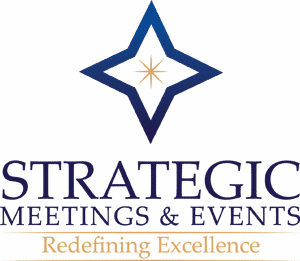Pink Collar Progression
By Lisa Plummer
Whenever someone asks her what she does for a living, Christy Lamagna often ends up doing a lot of explaining. Lamagna, president of Strategic Meetings and Events and a college instructor on strategic meeting and event planning, says the customary response when she tells people she’s an event planner is something along the lines of, “Oh, you plan parties and get to travel all the time. That must be so much fun!”
 “I take that moment to nicely but firmly share that I don’t plan parties,” says Lamagna. “I help my clients achieve their sales goals and enhance their marketing message.” In her 22-year career in the meeting planning industry, Lamagna has been unwavering in her mission to prove the value of face-to-face events. “Meeting planning is a misunderstood field,” she says. “We as an industry do not do enough to train newcomers to the profession about how to articulate what we do, nor do we have an organized voice in the industry to educate the public on what we do and why we are an integral part of business.”
“I take that moment to nicely but firmly share that I don’t plan parties,” says Lamagna. “I help my clients achieve their sales goals and enhance their marketing message.” In her 22-year career in the meeting planning industry, Lamagna has been unwavering in her mission to prove the value of face-to-face events. “Meeting planning is a misunderstood field,” she says. “We as an industry do not do enough to train newcomers to the profession about how to articulate what we do, nor do we have an organized voice in the industry to educate the public on what we do and why we are an integral part of business.”
While many industry and tourism associations have made efforts to promote the economic value of face-to-face events, many planners believe there is more work to be done when it comes to championing the profession itself. And though many event professionals feel highly valued by their companies and organizations, the profession deserves more credibility and respect.
THE PROGRESSION OF THE MEETING PLANNER
Meeting planning did not become an officially recognized profession until about 1972 when Meeting Professionals International was founded, according to George Fenich, Ph.D., a hospitality professor who has written about the history of the industry. At the time of its founding, MPI had 159 members, and more than 80 percent of them were men. Forty years later, women have become the lifeblood of meetings and events. According to MPI’s 2012 Annual Business Barometer, 75 to 80 percent of their meeting planner members working in the United States and Canada are women, making it a true pink-collar profession.
“Women tend to be detail-oriented with a natural ability to multitask, which are two components that are essential to success in the profession,” says Lamagna. “We tend to be drawn to organizing, people pleasing and helping others.” She thinks so many women are planners because the job plays straight into their skill sets. Heather Mason, president of A Caspian Production, thinks the role of the female meeting planner probably evolved from secretaries being asked to plan small events for their bosses, tasks which may have propelled them into roles as executive assistants, meeting planners and finally, meeting professionals. “Secretaries organized luncheons, luncheons turned into conferences and conferences turned into other things,” Mason says. “I’m hoping it became a profession because maybe some women said, ‘Hey, this is a job.’”
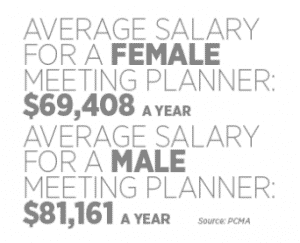 But despite the pervasive number of women who are meeting planners, a June 2012 PCMA study revealed that women’s salaries average 14 percent lower than those of their male counterparts. Women make an average of $69,408 a year. Men come in at $81,161.
But despite the pervasive number of women who are meeting planners, a June 2012 PCMA study revealed that women’s salaries average 14 percent lower than those of their male counterparts. Women make an average of $69,408 a year. Men come in at $81,161.
Why the disparity? Well, for one, it’s not far from the national gender gap average when it comes to salary. According to the Center for American Progress, women are still earning less than men across the board, with full-time female workers earning 77 percent of what men earned in 2010.
Another reason, suggests Lamagna, is the reputation of the profession. “I think women have entered into a profession that doesn’t garner enough respect because people think it’s party planning.”
“But the problem, no matter what,” Lamagna adds, “is that as an industry, we need to be recognized and be able to articulate why we’re valuable and what we do for companies. Until then, we won’t get better salaries and we won’t be viewed as the professionals we are.”
CHANGING THE REPUTATION
In truth, it’s not simply people outside the industry who have a misunderstanding of what’s involved in meeting planning. It’s the people inside it, too, especially newcomers. The job can include travel and cocktail receptions, but there are also budgets, disaster plans and event marketing. “If they don’t understand the field, they look at it for the perks,” says Lamagna. “Our job is so much deeper than that, but when a lot of folks get thrown into meetings without experience…they truly don’t know what they’re doing and all the work that is required.” That perpetuates the myth that the job is easy, she says.
It’s still common practice among some companies, in an effort to save money on event budgets, to assign the planning of events to in-house secretaries or executive assistants—typically women—who haven’t had any planning experience or training. And that is one of the biggest obstacles holding back the profession, suggests Mason. “I find that the more that secretaries take on these jobs and neglect allowing a professional to do it, the more it decreases the value, the integrity and the credibility of the entire profession,” says Mason. “Just like you wouldn’t want a budget surgery, it’s not free when you have somebody in-house [plan your event] because you just rack up liabilities, inefficiencies and costs.” Sometimes, the person who has been thrust into the role needs to communicate the importance of the position and move it forward. “It’s incumbent upon the people who are planning meetings without knowledge of what they’re doing to educate themselves, so they can do a better job and continue to elevate the profession,” says Lamagna.
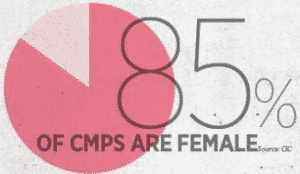 Experienced planners like Angela Layton, marketing and event specialist of Healthtech Holdings, can also do her part to raise the credibility of the profession. “I have had some experiences that made me feel misunderstood in terms of the value that I bring to an organization,” says Layton. “In reflection, many of these misunderstandings could have been resolved with conversations that focused on what the meetings and events portfolio brought to the table in terms of advancing the mission and vision to the company. Event professionals must remember that the value of meetings and events isn’t proven easily. It is something that all members of our profession must continually and collectively focus on to ensure success.”
Experienced planners like Angela Layton, marketing and event specialist of Healthtech Holdings, can also do her part to raise the credibility of the profession. “I have had some experiences that made me feel misunderstood in terms of the value that I bring to an organization,” says Layton. “In reflection, many of these misunderstandings could have been resolved with conversations that focused on what the meetings and events portfolio brought to the table in terms of advancing the mission and vision to the company. Event professionals must remember that the value of meetings and events isn’t proven easily. It is something that all members of our profession must continually and collectively focus on to ensure success.”
BUILDING CREDIBILITY
Solid, competitive educational offerings, whether through industry association certificate programs or college and university level degree programs, will build more legitimacy for the profession, says Mason. In light of the amount of education becoming more available for prospective and existing professionals, she’s not alone in that thinking. According to a July 2009 PCMA Education Foundation study on Meeting Management Programs in U.S. Higher Education, more than 200 U.S. colleges and universities offer courses in meeting and event planning, such as George Washington University and Indiana University-Purdue University Indianapolis, which both offer comprehensive event and meetings management programs that include certificate programs.
Programs offered by several industry associations also continue to meet industry demand, including the Certified Meeting Professional (CMP) designation offered by the Convention Industry Council. Established in 1985, the popular program has awarded CMP designations to approximately 14,000 individuals in 46 countries worldwide. According to the CIC, 85 percent of CMPs are women. Certification programs continue to grow in popularity, including the Certification in Meeting Management (CMM) designation created by MPI in the late ’90s for meetings professionals with more than 10 years of experience.
“Twenty years ago, we weren’t as recognized as a profession, [but] meeting planning is becoming a field that you can now train and study for,” says Lamagna. “Colleges are offering certificates in meeting planning and the industry just added the SMMP certification, which focuses on strategic planning. Online courses are more prevalent and certificate programs are common, but many are not as robust and comprehensive as necessary.”
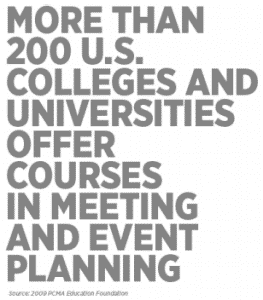 Although offering these programs is important, industry associations could do more for professional planners by making their educational offerings more competitive, as well as making concerted efforts to champion the profession, says Mason. “I see [the associations] as the forerunners of gaining more respect for this profession,” she says. “They could start this educational process—a significant, united campaign around respect and differentiation for the profession.”
Although offering these programs is important, industry associations could do more for professional planners by making their educational offerings more competitive, as well as making concerted efforts to champion the profession, says Mason. “I see [the associations] as the forerunners of gaining more respect for this profession,” she says. “They could start this educational process—a significant, united campaign around respect and differentiation for the profession.”
She also suggests an industry-wide shift in professional terminology. “The term ‘meeting planner’ has got to die,” says Mason. “It’s too easy to slip into the words ‘wedding planner’ or ‘party planner.’ ‘Planner’ to me just says you have the skill set to plan a sequence of events…We’re all planners in our day-to-day lives. Whereas if someone says they’re an event producer—I don’t produce things on a day-to-day basis, so I automatically assume that’s different from my skill set. Until we use different language, we can’t start to communicate that value proposition.”
Deborah Sexton, president of the Professional Convention Management Association, believes that while industry associations have more to accomplish when it comes to promoting the face-to-face industry and the planning profession, individual planners must also do their part within their own organizations and companies to gain greater credibility and prove their value, for example, taking on more event strategy responsibilities rather than solely logistics.
“There’s no reason we can’t work together to also develop a tool professionals can use to talk to their superiors about what they bring to the organization,” says Sexton. “But they also have to raise their hands up, to say, ‘Hey, I want to be there, I want to hear what it is you’re planning and I promise you if I hear it, I think I can execute better on that.’ They have to take on that extra task as well internally. If they’re quiet and all they do is execute a beautiful event logistically, that’s where it ends.” In addition, empowering women to take on more leadership roles would help bridge the gaps and correct the disparities between the sexes working in the industry, says Mason. One example is MPI’s Women’s Leadership Initiative, launched in 2001 to empower women to take more industry leadership roles (see sidebar on the state of the initiative, previous page).
“I definitely see a change and a maturing of the industry, and I think with that will come recognition of the fact that this is a profession,” says Mason. “That’s why I want women to be leaders…that it doesn’t have to be just men creating the companies and employing the women. Although there are a lot of significant female-owned management firms, I want to see more because if we’re going to dominate this industry, we should dominate the leadership as well, significantly.”
STEADY STRIDES
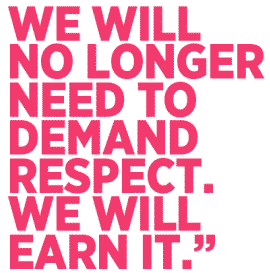 While more needs to be done to turn this pink-collar profession into a highly respected, highly regarded and highly paid one, strides have been made in recent years. Within the corporate planning field, many female planners and producers are getting the respect they deserve, especially those in charge of larger and more revenue-generating events and conferences.
While more needs to be done to turn this pink-collar profession into a highly respected, highly regarded and highly paid one, strides have been made in recent years. Within the corporate planning field, many female planners and producers are getting the respect they deserve, especially those in charge of larger and more revenue-generating events and conferences.
“I see women who are working at big computer and financial companies doing large events that make lots of money, and at that level, they’re getting what they’re asking for because they’re seen as incredibly valuable,” says Mason. “I think it’s more of the mid- to small-level companies where the old attitudes survive, and because there are so many of those you tend to hear more stories from those folks.”
Like many meeting and event planners, HealthTech’s Angela Layton loves and is passionate about her career. She recongnizes there is work to be done when it comes to gaining legitimacy and respect for the profession, but she feels fortunate to be in a field that fits her to a “T.”
“I enjoy providing opportunities for individuals to expand their skills, grow their networks and increase their personal value, and I enjoy being a part of the strategic direction of my company and the programs we implement to accomplish our goals and objectives,” says Layton. “Meeting professionals must continue to prove their value in terms of strategic contributions. By proving our strategic value, we will no longer need to demand respect. We will earn it.”
Tags: Pink Collar Progression, Progression, Planning Progression, Event Planning, Event Planners, Strategic Planners, Corporate Meetings, Corporate Events, Collaborate Meetings, Strategic Events, Collaborate Meetings
